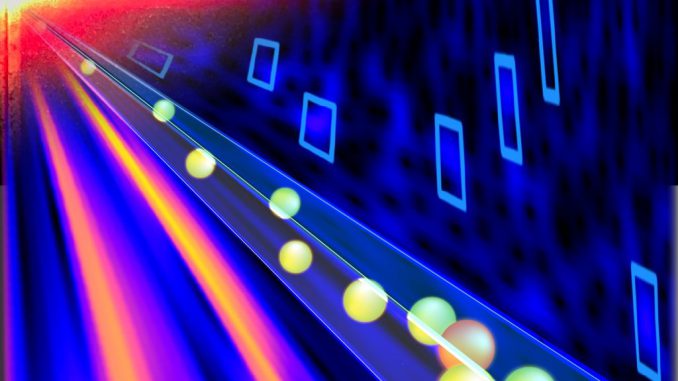
By Mark Waghorn
A new Star Trek-style device can carry out multiple medical tests – all at once.
The laser biosensor analyses completely different particles simultaneously – ranging from viruses to DNA.
The high-tech portable device is similar to the fictional Starfleet tricorder – a handheld scanner that instantly checks organ functions and detects diseases.
It is capable of flagging the barest presence in the blood of a specific virus, antibody or protein marker for a specific cancer.
The technology may even sniff out airborne chemical warfare agents while they are still far below toxic levels.
In experiments, it detected a mixture of nanobeads in concentrations across eight orders of magnitude.
It extends potential concentration levels by a factor of more than 10,000.
Lead author Dr. Holger Schmidt, of the University of California, Santa Cruz, said: “This work is our latest step in developing integrated optofluidic sensing devices that are sensitive enough to detect single biomolecules and work over a very wide range of concentrations.
“We have shown that this can be done with a single method, which allows us to simultaneously measure and distinguish multiple particle types at once even if they have very different concentrations.”
Other chip-based testing devices focus on one target because biomolecules come in many different forms and in vastly different amounts.
For example, the concentrations of various proteins used as disease biomarkers can vary by over ten orders of magnitude.
The team’s testing platform could be used for many. It combines optics and microfluidic channels on a silicon or plastic chip.
Particles are detected by illuminating them with a laser beam and then measuring the response with a light-sensitive detector.
It has the sensitivity to identify nucleic acids, proteins, viruses, bacteria and cancer biomarkers.
They previously used separate detectors and signal analysis techniques to measure particles with high and low concentrations.
This was necessary because if one type of particle type is present at a very high concentration, it creates a very large response that overwhelms the much smaller signals from another particle type present at low concentrations.
The new work demonstrates a signal processing method that can be used to detect particles in both high and low concentrations simultaneously, even if the concentrations are not known in advance.
High and low-frequency laser modulation distinguished single or multiple particles, respectively.
Dr. Schmidt said: “Secondly, we implemented a feedback loop that detects when signals are really large and adjust the input laser power accordingly.
“In this way, we can detect large signals from high concentrations without overwhelming the weak signals that may be present from another species at low concentrations.
“This allowed us to simultaneously detect particles that were present in very different concentrations.”
The researchers also applied an extremely fast algorithm to identify single particle signals at low concentrations.
Machine learning also helped with recognizing signal patterns so that different particle types could be distinguished with high accuracy.
Dr. Schmidt said: “These signal analysis advances are ideal for enabling device operation at the point of care where signal quality can be poor and where data analysis is required in real-time.”
The researchers demonstrated their new approach by pumping optofluidic biosensor chips with a solution of nanobeads at different concentrations and with various fluorescence colors.
They were able to correctly identify the concentration of both yellow-green and crimson bead concentrations even though their concentrations differed by a factor of more than 10,000 in the mixture.

Dr. Schmidt added: “While this work advances a specific integrated sensor that is based on optical fluorescence signals, the signal analysis technique can be used with any type of time-dependent signal that covers a wide concentration range.
“This can include different optical signals but also electrical sensors.”
The team’s optofluidic biosensing technology described in the journal Optica is currently being commercialized by medical device company Fluxus Inc.
The researchers are also working to adapt their methods to study molecular products from artificial neuronal cell tissue organoids.
The project could provide further insight into areas such as Alzheimer’s and other neurodegenerative diseases and child cancers.
Produced in association with SWNS Talker
Edited by Saba Fatima and Asad Ali
The post Star Trek-Style Device Detects Multiple Medical Tests Simultaneously appeared first on Zenger News.
